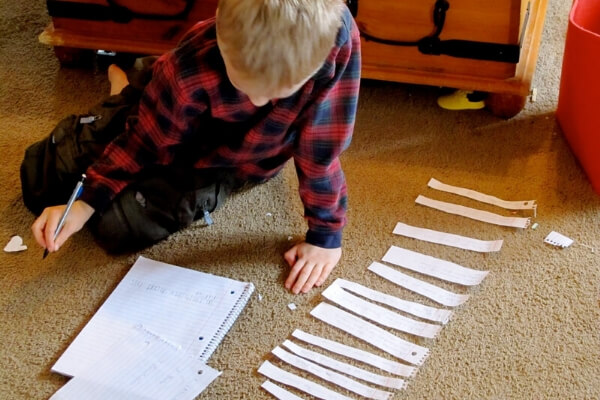Homeschooling is a marathon, not a sprint. Learn how to look beyond the short term and make long term homeschool goals for your kids, and what those goals should look like.
When you are in the thick of day to day homeschooling, it can be easy to get bogged down by short term goals.
** This website contains affiliate links. If you make a purchase using one of these links, I may earn a commission. Please click here for more information about cookies collected and our privacy policy **.
It’s easy to forget the bigger picture and instead worry about things like assignment sheets, math facts, and keeping up with public school educational benchmarks and standards.
But if you take a step back and evaluate what you want for your children as young adults and beyond.
When your children are young adults, ready to face the world on their own, it won’t matter that they didn’t finish their assignment sheet that one week in 3rd grade or that they didn’t have their addition facts memorized until really late.
It won’t matter if they started reading at age 4 or age 10.
What will matter is WHO they are.
In order to keep this in mind when you are tired, stressed out, or worried that your kids are behind, you need to set long term homeschooling goals. And then keep these goals in mind throughout the entire homeschool journey.
So let’s talk about how to set long term homeschool goals and what they should look like.

How to Set Long Term Homeschool Goals for Your Kids
Evaluate Your Priorities
The first step is to evaluate your priorities and determine what is really important to you.
Close your eyes and picture your child as a young adult, just about to go out into the world on his own.
Maybe he’s moving into his own apartment or maybe he is moving half way across the country to live in a university dorm room.
Take a minute to think about who you want him to be. What are the most important things that he know? What skills should he have?
Write down what comes to your mind. Be broad, yet specific. What types of things make the long term cut? This will be different for every family, some things are more important than others depending on the individual.
Some items on your list might be:
- Be able to care for themselves. These include life skills like cooking, cleaning, getting places on time, paying the bill, etc.
- Know how to research. They should know HOW to learn so that they can seek out any knowledge they need in their adult life.
- Be a good person. These are values and character traits that will likely be somewhat different for every family.
- Be hard working. This specific value is so important for so many aspects of adult life
- Be able to communicate effectively. Communication skills should never be overlooked!
Notice how nothing listed so far is academic? All those academic goals tend to fall to the bottom of most of our lists.
Of course some academic long term goals will make the list. Such as getting into a good college (every family will be different, I don’t prioritize college for my kids at all).
But make this list so you can get a very good idea of what the most important things are in your family and your homeschool.

Create a Plan
Once you have a list of your most important values, skills, and academic priorities, it’s time to make a plan.
The problem for most people when it comes to make goals actually happen is that they don’t plan. There’s a quote I love by Antoine de Saint-Exupéry that says: “A goal without a plan is just a wish.”
And that is true for almost all aspects of life!
So if you want to actually meet your long term homeschooling goals, you need to create a plan.
The general steps for creating a plan to meet your goals is to break them down into smaller goals. And then break those down into smaller steps. And on an on.
How small your steps are will likely depend on the age of your kids and how long you have until they are out on their own.
So, for example. If one of your goals is for your kids to leave home with the knowledge to take care of them selves, then you need to make sure you add life skills training into their day to day life.
You would add things like:
- Cooking and baking education (knife skills, how to read a recipe, safety, nutrition, etc)
- Chores (such an important part of homeschooling and parenting!)
- Finance (balancing checkbooks, writing checks, simple accounting, budgeting, paying bills, etc)
If you are a new homeschooler, you may be saying to yourself, but that’s not SCHOOL, that’s LIFE and parenting!
And you are right. But I would wager that most seasoned homeschoolers will tell you that there really isn’t a difference between the two. Homeschooling is a way of life. Education and family life are so tightly intertwined that it’s almost impossible to separate. And as we already talked about above, the MOST important goals are not actually academic.
But academic long term goals can be broken down as well. For example, the ‘get into a good college’ goal from above might include things like:
- GPA benchmarks for high school
- High School course load
- Extracurriculars
But in my experience, even this long term goal doesn’t really need attending to until your kids reach high school age. Kids have the tremendous ability to ‘catch up’ as they mature.
And remember, almost all long term goals will require something academic when broken down:
- To be able to research you must know how to read.
- To communicate effectively you must know something about language, sentence structure and writing.
- To get somewhere on time, you need to be able to tell time and subtraction
- To pay bills and budget you need to know how to add and subtract money.
Those are simplistic examples, but you get the picture. I am not telling you to forget about academics, I am just trying to show you the bigger picture. It doesn’t necessarily matter WHEN they learn it, but that they DO learn it.

My son at age 9, learning to research and take notes for a paper on Eddy Arnold
Use Short Term Goals
Short term goals are where you put the pieces of your long term homeschooling goals into action.
It’s where you make goals like telling time, reading fluently, and writing a research paper. Those short term goals will help your child reach the long term goals.
If you want your child to be able to cook for himself and not just live on canned soup and ramen noodles, you can’t shoo him out of the kitchen when he wants to help, you can’t make everything for him and you have let him take the risk of burning himself or the food and making mistakes. Take incremental steps to teach him or her how to cook.
If you spoon feed your child all of their knowledge and never work on how to find information he will end up lost in the university library while trying to write his first paper. So short term goals that include researching and reading and then writing about what they learned are very important.
Write down those little goals; whether it is to get your first grader reading fluently or your 7th grader up to grade level in math.

My boys learning the value of hard work, plus math, building, and leveling skills while they help build a chicken coop
Remember the Big Picture
Memorization of math facts or history dates don’t make the cut when it comes to long term goals. I save those for short term goals.
All those little academic benchmarks are perfect for putting on your yearly goals planner. You know, at the beginning of the year when everything is fresh and exciting. When your desk and computer screen are full of lesson plans and assignment sheets or fun ideas from Pinterest?
But when things get hard, when the January blahs hit, when you are so burned out you can’t function or your kids refuse to do anything other than fight and complain.
That’s when it is important to remember the long term.
That it’s okay if your 11 year old still uses his finger to add and subtract.
It’s okay that your 4th grader still writes a few numbers backwards.
And it’s okay that your 1st grader is struggling to read.
It will happen eventually and there is still plenty of time.

Fostering the love of learning is one of the most important parts of homeschooling
One last thing to think about when it comes to long term homeschooling goals, especially during the high school years.
Take into account your child and their future plans. Most high schoolers have somewhat of an idea of what they want in the future. What information do they need in order to achieve that goal?
For example, I have graduated 2 sons already, one of them is an auto mechanic and one is heading to culinary school. Both of them knew exactly where they were going by the time they were in 9th or 10th grade.
Neither of those 2 fields requires an extensive knowledge of science or history. That meant that our academic goal was less about mastery and more about having a thorough general knowledge. It didn’t matter to me if they memorized the stages of mitosis, because that knowledge wouldn’t serve them in their futures. What would serve them is a good round education, so that if somewhere down the road mitosis comes up in conversation, they wouldn’t be totally uneducated and dumb on the topic.
Because in the my goal, like many of you, is to graduate a well rounded, educated, fully-functioning, GOOD person.
It’s hard not to get caught up in the day to day. It’s natural in our society to think in terms of “grade level” and standardized tests.
But as homeschoolers we have the unique ability to move past that. We don’t have to keep up with standards and timelines.
So broaden your outlook every so often and look at the big picture. Then help you raise and teach your children to be the best they can be.
You May Also Like:
17 Chores Your 3 Year Old Can Do
How to Homeschool with a Toddler in the House


